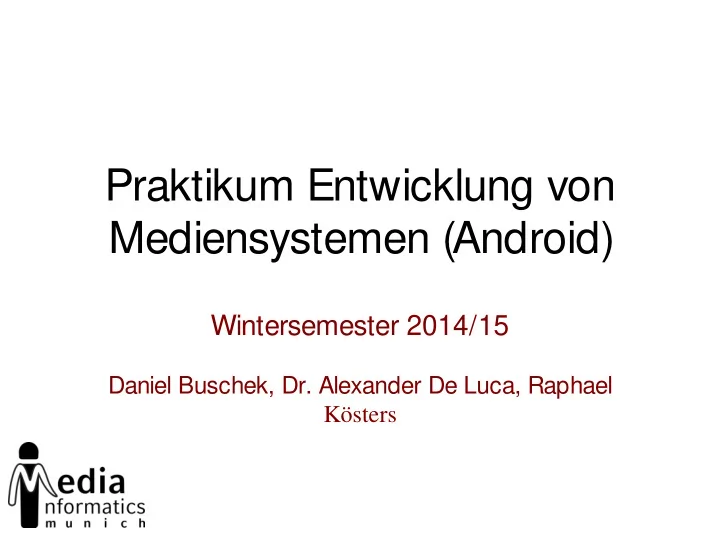

Praktikum Entwicklung von Mediensystemen (Android) Wintersemester 2014/15 Daniel Buschek, Dr. Alexander De Luca, Raphael Kösters
Today • Organization • Android 101 • Hands-On • Assignment 01 October 9, 2014 PEM (Android) - WS 2014 /15 2
Organization • Android! • 6 ECTS • Bachelor: Vertiefendes Thema • Master: Gruppenpraktikum • Thursday, 16-18h, Amalienstr. 17, A107 • koestersr@ cip.ifi.lmu.de • http://www.medien.ifi.lmu.de/lehre/ws1415/pem/ • Hand in assignments via Uniworx October 9, 2014 PEM (Android) - WS 2014 /15 3
Roadmap • October: Lectures – Individual assignments • November, December, January: App development in teams – Groups of 4 (tbc) – 4 Milestone presentations (everyone is up once) • January: Final presentation and showcase • Next lectures: 16.10. and 30.10.2014 October 9, 2014 PEM (Android) - WS 2014 /15 4
ANDROID 101 October 9, 2014 PEM (Android) - WS 2014 /15 5
Android in a Nutshell • AOSP (Android Open Source Project) maintaining code, open source • Linux subsystem • Specialized Java VM (Dalvik and ART) • Currently version 4.4 (KitKat) • Google adds additional services – Google Play Store – Google Apps (Mail, Chrome, Maps, …) October 9, 2014 PEM (Android) - WS 2014 /15 6
Lots of Cool Features • Multiple sensors – Accelerometer, gyroscope, magnetometer, • Communication interfaces – NFC, Bluetooth LE, Wifi, cellular • GPS and cell location • Cameras • High definition displays • Hardware keys and virtual controls October 9, 2014 PEM (Android) - WS 2014 /15 7
Programming Languages • Mainly: Java (converted to Dalvik bytecode) – Baseline 1.6, some features of 1.7+ – Limited namespace from classic JDK – Additional namespaces for new features • Resources: XML – Layouts – Resource files (localizations, settings) • NDK for native C/C++ programming October 9, 2014 PEM (Android) - WS 2014 /15 8
Limitations and Things to Consider System Resources • Apps compete for the “main” display • Could be paused/terminated at all time • Can be interrupted by various events – Phone call – App switch – … • Limited number of resources available October 9, 2014 PEM (Android) - WS 2014 /15 9
Limitations and Things to Consider Network Connectivity • Changing network availability • Flaky connectivity and unpredictable bandwidth • Plan accordingly – Keep the in/out data small – Cache static data • Network requests must be executed on separate threads (i.e. not on main thread) October 9, 2014 PEM (Android) - WS 2014 /15 10
Limitations and Things to Consider Device Fragmentation • Multitude of different device configurations out in the wild – Screen size and resolution – Features and sensors – … • No standard configuration that can be targeted • Low adaptation rate of new Android versions (if available at all) October 9, 2014 PEM (Android) - WS 2014 /15 11
Version Distribution http://developer.android.com/about/dashboards/index.html October 9, 2014 PEM (Android) - WS 2014 /15 12
Developer Tools Android Developer Tools(Eclipse) October 9, 2014 PEM (Android) - WS 2014 /15 13
Developer Tools Android Studio (IntelliJ) October 9, 2014 PEM (Android) - WS 2014 /15 14
HANDS-ON October 9, 2014 PEM (Android) - WS 2014 /15 15
Developer Tools SDK and Emulator Emulator images for almost all Android versions Intel provides x86 images that vastly increase performance (install via SDK Manager) October 9, 2014 PEM (Android) - WS 2014 /15 16
Project Structure /src Source files within respective packages /res Resources, including layouts, image assets and localizations /libs Precompiled libraries (jars) used for the project /gen Auto-generated files (changes will be overwritten) October 9, 2014 PEM (Android) - WS 2014 /15 17
Anatomy of an Android App Manifest.xml • General app settings – App unique identifier (package) – API version targets • Contains available Activities and Services • Lists required permissions • Additional ways to define IntentFilter, BroadcastReceiver and Provider • Can also be used specify hardware requirements October 9, 2014 PEM (Android) - WS 2014 /15 18
Anatomy of an Android App Activities & Services • Activity is main UI element that is being displayed • Normally takes up the entire screen • Specific lifecycle for various states • New Activities will be stacked on top • Long running operations should be handled in a Service • Different runtime behavior, running in background • Multiple Activities can bind to one service October 9, 2014 PEM (Android) - WS 2014 /15 19
Anatomy of an Android App Layouts & Resources • UI layouts are defined in special XML files • All resources automatically have a unique id assigned which are used as a reference throughout the app • Easy to adapt localization functionality • Automatic resource selection based on device capabilities October 9, 2014 PEM (Android) - WS 2014 /15 20
ADDITIONAL INFORMATION October 9, 2014 PEM (Android) - WS 2014 /15 21
Assignment 01 • Individual assignment • Set up development environment • First steps with Android • Layouts, Widgets, Interaction, http • Due next week (16.10.) • Submission via Uniworx October 9, 2014 PEM (Android) - WS 2014 /15 22
Next Lecture • Next lecture next week 16.10.2014 October 9, 2014 PEM (Android) - WS 2014 /15 23
Resources • Android Developers – http://developer.android.com/design – http://developer.android.com/training – http://developer.android.com/guide • Google IO Session Recordings – https://developers.google.com/events/io/2012 – https://developers.google.com/events/io/2013 • Google IO Schedule App – https://code.google.com/p/iosched October 9, 2014 PEM (Android) - WS 2014 /15 24
Recommend
More recommend